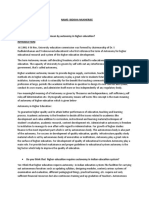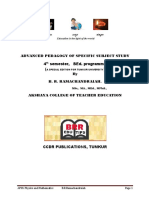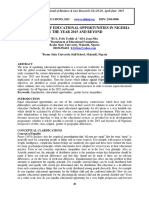0 ratings0% found this document useful (0 votes)
184 viewsIn - Service Teacher Education Under: Aroob Parween
In - Service Teacher Education Under: Aroob Parween
Uploaded by
Hello ChanduThe document discusses in-service teacher education under the District Primary Education Programme (DPEP) in India. DPEP was launched in 1994 with the objectives of universalizing primary education access, improving retention, learning achievement, and reducing disparities. It adopts a district-level, participatory approach focusing on local conditions. Teacher training is emphasized through institutions like DIETs, CRCs, and BRCs to improve classroom transactions and quality of education. Funding is primarily from the central government. Self-evaluation questions are provided to analyze DPEP's contributions and drawbacks.
Copyright:
© All Rights Reserved
Available Formats
Download as PDF, TXT or read online from Scribd
In - Service Teacher Education Under: Aroob Parween
In - Service Teacher Education Under: Aroob Parween
Uploaded by
Hello Chandu0 ratings0% found this document useful (0 votes)
184 views16 pagesThe document discusses in-service teacher education under the District Primary Education Programme (DPEP) in India. DPEP was launched in 1994 with the objectives of universalizing primary education access, improving retention, learning achievement, and reducing disparities. It adopts a district-level, participatory approach focusing on local conditions. Teacher training is emphasized through institutions like DIETs, CRCs, and BRCs to improve classroom transactions and quality of education. Funding is primarily from the central government. Self-evaluation questions are provided to analyze DPEP's contributions and drawbacks.
Original Description:
Original Title
MEd19
Copyright
© © All Rights Reserved
Available Formats
PDF, TXT or read online from Scribd
Share this document
Did you find this document useful?
Is this content inappropriate?
The document discusses in-service teacher education under the District Primary Education Programme (DPEP) in India. DPEP was launched in 1994 with the objectives of universalizing primary education access, improving retention, learning achievement, and reducing disparities. It adopts a district-level, participatory approach focusing on local conditions. Teacher training is emphasized through institutions like DIETs, CRCs, and BRCs to improve classroom transactions and quality of education. Funding is primarily from the central government. Self-evaluation questions are provided to analyze DPEP's contributions and drawbacks.
Copyright:
© All Rights Reserved
Available Formats
Download as PDF, TXT or read online from Scribd
Download as pdf or txt
0 ratings0% found this document useful (0 votes)
184 views16 pagesIn - Service Teacher Education Under: Aroob Parween
In - Service Teacher Education Under: Aroob Parween
Uploaded by
Hello ChanduThe document discusses in-service teacher education under the District Primary Education Programme (DPEP) in India. DPEP was launched in 1994 with the objectives of universalizing primary education access, improving retention, learning achievement, and reducing disparities. It adopts a district-level, participatory approach focusing on local conditions. Teacher training is emphasized through institutions like DIETs, CRCs, and BRCs to improve classroom transactions and quality of education. Funding is primarily from the central government. Self-evaluation questions are provided to analyze DPEP's contributions and drawbacks.
Copyright:
© All Rights Reserved
Available Formats
Download as PDF, TXT or read online from Scribd
Download as pdf or txt
You are on page 1of 16
M.Ed semester 2 ; C.C.
6 ; Unit :2
In –service teacher education under
DPEP
Aroob Parween
Research Scholar
Department of Education
P.U.
Objectives
After going through this topic, students will be able to:
Understand the concept & functions of DPEP.
Understand the objectives of DPEP.
Analyze the significance of DPEP in teacher education.
Content
Concept of DPEP
Objectives
Significance
Funding
Planning process
Quality improvement under DPEP
a. Teacher training
b. Academic support institutions
Self evaluation questions
District Primary Education Programme
The centrally—sponsored scheme of District Primary
Education Programme (DPEP) was launched in 1994 as a
major initiative to revitalize the primary education system
and to achieve the objective of universalisation of primary
education.
DPEP adopts a holistic approach to universalize access,
retention and improve learning achievement and to reduce
disparities among social groups.
Adopting an “area specific approach” with district as the unit,
of planning, the key strategies of the programme have been
to retain the sensitivity to local conditions and ensuring full
participation of the community.
It also seeks to strengthen the capacity of national, state and
district institutions and organisation, for planning,
management and professional support in the field of primary
education.
DPEP is based on the principle of “additionally” and is
structured to fill in the existing gaps by providing inputs over
and above the provisions made under central and state sector
schemes for primary education.
Objectives
To provide all children access to primary education through either
the formal or non-formal stream.
To reduce differences in enrolment, drop-out rates and learning
achievement among gender and weaker section groups to less than
five percent.
To reduce overall primary dropout rates for all children to less
than 10 percent.
To rise the average achievement rate by 25 percent by measured
baseline level and ensuring achievement of basic literacy and
numeracy competencies and minimum of 40 percent achievement
in other competencies by all primary education children.
Significance
The DPEP has made decisive impact on :
increasing enrolment
reducing stagnation
improving class-room transaction.
While the DPEP has been operational in
backward districts with female literacy below the national
average, total literacy campaign has started up the demand
for elementary education.
Funding
DPEP is an externally aided project. 85 percent of the project
cost is met by the Central Government and the remaining 15
percent is shared by the concerned state government. The
central government share is resourced through external
assistance.
Planning process
Planning process and project formulation under DPEP is of
great significance. DPEP emphasizes location-specific
planning in a participatory manner. In a sense there are some
basic postulates which need to be born in mind for DPEP
planning processes, namely the “nine pillars”. DPEP planning
should include :
(i) Mobilization for UEE by activating village education
committees, teachers, parents/guardians and linking up with
efforts under the Total Literacy Campaign.
(ii) Planning for primary education and not merely primary
schooling. Alternative methods have significance and a
holistic view be taken.
(iii) Cover all qualitative aspects such as school effectiveness,
textbooks, teacher training and improvement in simple
reading and learning skills.
(iv) Convergence of services, such as primary education,
primary health and ECCE to provide synergistic
development
(v) Provision for training's to improve teacher motivation and
classroom transactions, as also in management of education.
(vi) Openness to innovations which thrown up new solutions
and once tested can be scaled up, or aborted if unsuccessful.
(vii) A marked gender focus to provide for improvement in
access, retention and achievement levels of girls education, as
also to permeate gender sensitivity through all aspects of
DPEP planning, including teacher training/recruitment,
textbooks other educational facilities and incentives.
(viii) The canvas of DPEP is systemic where the issue is one of
management of change and improving of the system.
(ix) Evaluation monitoring and research are interactive and
supportive of DPEP. Studies and evaluations will play a major
role in project planning and action research to facilitate
decision-making.
Quality improvement under DPEP
Quality improvement is one of the stated objectives of DPEP
and focus is on ensuring improvement in teaching learning
processes. This is being attempted through :
renewal of curriculum and teaching learning material (TLM)
teacher training and empowerment
provision of decentralised academic support
capacity building of institutions.
Teacher training
(a) Strengthening the teachers in-service training and
development of new designs for such training.
(b) Selection and training of master trainers and resource
persons within the district.
(c) Training of educational administrators including district and
block level functionaries and VEC members.
(d) Augmenting the DIETs
(e) Any other activity/facility required for continuous and
updated training.
Academic support institutions
It may be stated that teacher development is a continuing
process with regular academic support. The CRC's (Cluster
Resource Centric) plans such inputs for a group of 8 to 10
villages, and BRC's (Block Resource Centre) for a group of 8
to 10 clusters.
The block or mandal level resource centers are being set up
to provide onsite support to teachers in terms of school
visits, demonstrations and feedback, teacher training,
material preparation discussion of specific problems at
monthly meetings etc.
DlETs which provide academic and resource support to
elementary education have been identified as technical and
professional resource institutions.
DlETs have taken up number of activities. In service teacher
training include sensitizing them about academic monitoring
and supervision, planning for action research, Mapping out
Total Literacy Mission (TLM).
The state councils of Educational Research and Training also
extended academic support. The faculties of SCERT are
involved in a range of quality improvement interventions.
Self evaluation questions:
Q. Discuss the contributions of DPEP in India .
Q. Discuss the drawbacks of DPEP scheme.
Topic for next class:
“In-Service teacher education under SSA”
Contact :
Email id - aroobparween@gmail.com
Mobile -9955142371
You might also like
- As in The Counselling RoomDocument4 pagesAs in The Counselling Roomandrei crisnic100% (1)
- Leadership Challenges in Nigeria SchoolsDocument18 pagesLeadership Challenges in Nigeria SchoolsAcademic JournalNo ratings yet
- Jupiter EngDocument34 pagesJupiter EngakukauakuNo ratings yet
- Online AssignmentDocument9 pagesOnline AssignmentJoseph JoseNo ratings yet
- E TDocument5 pagesE Tsinghsanya100% (2)
- Role of SMDC 3Document7 pagesRole of SMDC 3Manas BeckNo ratings yet
- Vocationalization of Secondary Education in India - Final - 1Document12 pagesVocationalization of Secondary Education in India - Final - 1Sajid AnsariNo ratings yet
- Role of SMDC For Universalisation of Secondary EducationDocument9 pagesRole of SMDC For Universalisation of Secondary EducationAJAY KUMAR BEHERANo ratings yet
- Concepts and Importance of Pre-Service Teacher Education at Elementary and Secondary LevelsDocument15 pagesConcepts and Importance of Pre-Service Teacher Education at Elementary and Secondary LevelsDr. Nisanth.P.M100% (1)
- Ict and Curriculum Transaction: P - 107 Neelmani Pandey Roll No 39, Sec-ADocument14 pagesIct and Curriculum Transaction: P - 107 Neelmani Pandey Roll No 39, Sec-ANeil pandeyNo ratings yet
- The National Policy On Information and Communication Technology (Ict) in School EducationDocument38 pagesThe National Policy On Information and Communication Technology (Ict) in School Educationnao1111No ratings yet
- Maintaining The Standard in Teacher EducationDocument7 pagesMaintaining The Standard in Teacher EducationAnonymous CwJeBCAXp0% (1)
- Ncfte 2009Document3 pagesNcfte 2009rahul pandeyNo ratings yet
- Examining The Centralized and Non-CentraDocument12 pagesExamining The Centralized and Non-CentraladyjebatNo ratings yet
- Objectives of Teacher EducationDocument15 pagesObjectives of Teacher EducationWaseem Khurshid ButtNo ratings yet
- Social Oriented Curriculum For Social ReconstructionDocument12 pagesSocial Oriented Curriculum For Social Reconstructionbabitha sujanna100% (1)
- Ganpat Vidyalay: Pre-Primary/Primary/A M Patel Sec/Hi-Sec (Sci/Com)Document4 pagesGanpat Vidyalay: Pre-Primary/Primary/A M Patel Sec/Hi-Sec (Sci/Com)Hetvi RathodNo ratings yet
- DietDocument2 pagesDietSanjay PalNo ratings yet
- Assignment AutonomyDocument6 pagesAssignment AutonomySouvik MukherjeeNo ratings yet
- LECTURE 17 - Stakeholders in Curriculum PlanningDocument3 pagesLECTURE 17 - Stakeholders in Curriculum PlanningAeleu Joverz100% (1)
- Summary, Conclusions, Educational Implications and Suggestions For Further ResearchDocument19 pagesSummary, Conclusions, Educational Implications and Suggestions For Further ResearchMUSTAQ AHAMADNo ratings yet
- Effective Classroom CommunicationDocument21 pagesEffective Classroom CommunicationCylus KipkuruiNo ratings yet
- Patterns of CurriculumDocument6 pagesPatterns of CurriculumNimra MalikNo ratings yet
- MHRD Main Working AreaDocument3 pagesMHRD Main Working AreaarastuNo ratings yet
- Role of Edusat It'S Functions in EducationDocument3 pagesRole of Edusat It'S Functions in EducationchamaNo ratings yet
- Role of The HeadmasterDocument3 pagesRole of The HeadmasterSujit Singh100% (1)
- Review How Philosophical Contributions of John Dewey Could Be Used For EducationDocument2 pagesReview How Philosophical Contributions of John Dewey Could Be Used For EducationGamini HettiarachchiNo ratings yet
- What Is Curriculum DevelopmentDocument12 pagesWhat Is Curriculum DevelopmentJessa Mae Banquirig100% (1)
- Rashtriya Madhyamik Shiksha Abhiyan (RMSA)Document6 pagesRashtriya Madhyamik Shiksha Abhiyan (RMSA)anju clNo ratings yet
- Inclusive Education - What It IsDocument3 pagesInclusive Education - What It IsmihaelahristeaNo ratings yet
- District Primary Education ProgrammeDocument4 pagesDistrict Primary Education ProgrammeSajid AnsariNo ratings yet
- About MHRDDocument2 pagesAbout MHRDSanthanu Surendran100% (1)
- Meaning and Nature of CCEDocument2 pagesMeaning and Nature of CCEAnisha DasNo ratings yet
- Meaning and Definition of Social ScienceDocument5 pagesMeaning and Definition of Social ScienceROSEMARY K P100% (1)
- Online Assignment LekshmiDocument7 pagesOnline Assignment LekshmiPreethi VNo ratings yet
- NCTEDocument4 pagesNCTESanjay PalNo ratings yet
- National Seminar On Challenges For Quality Teacher Education in The Present ScenarioDocument3 pagesNational Seminar On Challenges For Quality Teacher Education in The Present ScenarioARUL LAWRENCENo ratings yet
- Objectives of Distance EducationDocument2 pagesObjectives of Distance EducationLing Siew EeNo ratings yet
- 8605 Assignment No 1Document27 pages8605 Assignment No 1Naila BibiNo ratings yet
- Equality of Educational Opportunities-1Document40 pagesEquality of Educational Opportunities-1sindhu molNo ratings yet
- M.Ed. 08 Advanced Educational Research and StatisticsDocument102 pagesM.Ed. 08 Advanced Educational Research and Statisticsabcd zNo ratings yet
- Curriculum Development and EvaluationDocument64 pagesCurriculum Development and EvaluationSuleman ShahNo ratings yet
- Instructional Aid in Teaching HistoryDocument8 pagesInstructional Aid in Teaching HistorygechlemuNo ratings yet
- Apss SimpleDocument79 pagesApss SimpleDhanush SONo ratings yet
- Commerce VII I Module 3 and 4Document27 pagesCommerce VII I Module 3 and 4ABHSNo ratings yet
- Equity and Excellence: Glimpses From Secondary Education of IndiaDocument9 pagesEquity and Excellence: Glimpses From Secondary Education of Indiadeepti sharmaNo ratings yet
- M.ed. Syllabus (2 Year) of Odisha MEd CollegeDocument94 pagesM.ed. Syllabus (2 Year) of Odisha MEd Collegemkray0No ratings yet
- Assignment # 1: Identify The Weaknesses and Strengths of Educational System of Pakistan?Document3 pagesAssignment # 1: Identify The Weaknesses and Strengths of Educational System of Pakistan?Shiny MerrimentNo ratings yet
- Role of Mass-Media in Education in IndiaDocument21 pagesRole of Mass-Media in Education in IndiaSuresh ShahNo ratings yet
- 8603-1 SanaDocument28 pages8603-1 SanaAreeba M.jNo ratings yet
- Major InstitutionsDocument4 pagesMajor InstitutionsKayse Nashe100% (1)
- Equality of Educational OpportunityDocument7 pagesEquality of Educational OpportunityjuliusNo ratings yet
- The Educational SupervisionDocument7 pagesThe Educational SupervisionAngel Mamani CruzNo ratings yet
- Selecting Learning ExperiencesDocument34 pagesSelecting Learning Experiencesfreddo100% (1)
- Implementation of CCEDocument2 pagesImplementation of CCEShiwaniNo ratings yet
- Education of EconomicsDocument13 pagesEducation of EconomicsSharanu PatilNo ratings yet
- Dr. Sandhya Sharma - Divya - SharmaDocument15 pagesDr. Sandhya Sharma - Divya - SharmaSanskar VermaNo ratings yet
- RusaDocument16 pagesRusaAncilin ChandraNo ratings yet
- Japan Germany Educ SystDocument7 pagesJapan Germany Educ SystJamaica Malunes ManuelNo ratings yet
- In Serviceeducation 160618131717Document34 pagesIn Serviceeducation 160618131717revathidadam55555No ratings yet
- Governance and the Three Arms of Government in Sierra LeoneFrom EverandGovernance and the Three Arms of Government in Sierra LeoneNo ratings yet
- School Infrastructure in Paraguay: Needs, Investments, and CostsFrom EverandSchool Infrastructure in Paraguay: Needs, Investments, and CostsNo ratings yet
- 4.0 Classification Methodologies RDocument200 pages4.0 Classification Methodologies RDionie Wilson DiestroNo ratings yet
- RUECKERT Literature and EcologyDocument10 pagesRUECKERT Literature and EcologyFiNo ratings yet
- E3 Operating AuditingDocument21 pagesE3 Operating AuditingPaupauNo ratings yet
- Full Ebook of Decolonization and The State in Kenya 1St Edition David F Gordon Online PDF All ChapterDocument69 pagesFull Ebook of Decolonization and The State in Kenya 1St Edition David F Gordon Online PDF All Chapteralysoncofy100% (6)
- Vighnesh Resume UpdatedDocument4 pagesVighnesh Resume UpdatedVighnesh Bhat MNo ratings yet
- Gartner Protect Your Business Assets With A Roadmap For Maturing Information Security RoadmapDocument13 pagesGartner Protect Your Business Assets With A Roadmap For Maturing Information Security Roadmapjesus_yustasNo ratings yet
- What Will You Learn From This Module?: Module 4: "Laro NG Lahi"Document10 pagesWhat Will You Learn From This Module?: Module 4: "Laro NG Lahi"Denise Ortiz ManolongNo ratings yet
- Small WorldDocument13 pagesSmall WorldMihaela Nicoleta Cotos CraioveanuNo ratings yet
- Hyperbolic FunctionsDocument8 pagesHyperbolic FunctionsHarirajVenkatesanNo ratings yet
- Introduction To Human Neuroimaging - Chapter 10Document13 pagesIntroduction To Human Neuroimaging - Chapter 10thelazyllama444No ratings yet
- Chapter 1 NotesDocument5 pagesChapter 1 NotesUday ModiNo ratings yet
- List of Irregular Verbs (Past and Participle)Document3 pagesList of Irregular Verbs (Past and Participle)Clarissa DiasNo ratings yet
- EQEmu Guidebook13Document203 pagesEQEmu Guidebook13hateborne100% (1)
- Cross Curricular TokDocument25 pagesCross Curricular TokNatasha FrancisNo ratings yet
- Assessment TestsDocument8 pagesAssessment TestsNidhi Shah100% (1)
- Mathematics - 9th Class PDFDocument13 pagesMathematics - 9th Class PDFNitish MehraNo ratings yet
- Writing 3Document2 pagesWriting 3Refaya MahmudaNo ratings yet
- Random Variable2Document19 pagesRandom Variable2alan conradoNo ratings yet
- F240 Early Childhood Education Inners FINAL Web PDFDocument319 pagesF240 Early Childhood Education Inners FINAL Web PDFTamrola100% (1)
- Estimating K From CPT and CPTU Data PDFDocument8 pagesEstimating K From CPT and CPTU Data PDFAnonymous CQ4rbzLVENo ratings yet
- 15-21 Employment News PDFDocument63 pages15-21 Employment News PDFMohan RavindranNo ratings yet
- Faxt Sheet Idx 30Document2 pagesFaxt Sheet Idx 30WendykuswiandiNo ratings yet
- Anthropometric AssessmentDocument11 pagesAnthropometric AssessmentMelinda KaniaNo ratings yet
- 613 Commandments-1: Debbie Friedman - Capo IV For Original KeyDocument2 pages613 Commandments-1: Debbie Friedman - Capo IV For Original KeyjmsklarNo ratings yet
- Fermi DistrbutionDocument17 pagesFermi DistrbutionnazarNo ratings yet
- Lesson 9 - The Bread of LifeDocument10 pagesLesson 9 - The Bread of LifeMarc Lenson EtangNo ratings yet
- TAW 10 Week1 DumpsDocument11 pagesTAW 10 Week1 DumpsBrijesh GandhiNo ratings yet
- Symbiosis QuizDocument18 pagesSymbiosis Quizapi-110789702No ratings yet

























































































